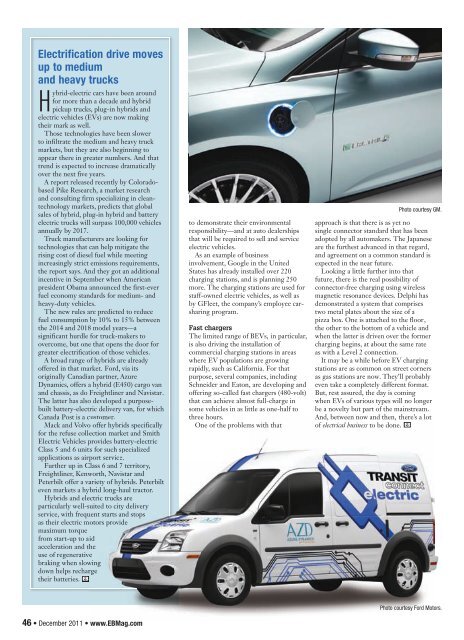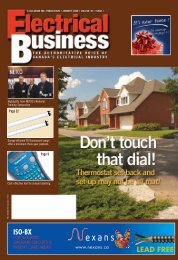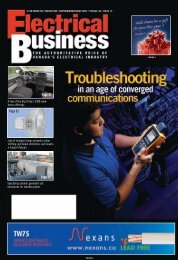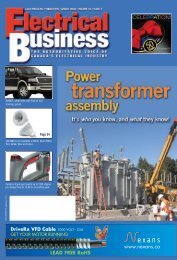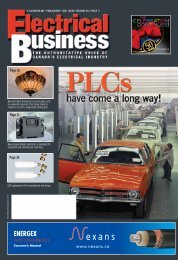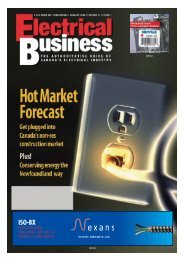DECEMBER 2011 - Electrical Business Magazine
DECEMBER 2011 - Electrical Business Magazine
DECEMBER 2011 - Electrical Business Magazine
You also want an ePaper? Increase the reach of your titles
YUMPU automatically turns print PDFs into web optimized ePapers that Google loves.
Electrification drive moves<br />
up to medium<br />
and heavy trucks<br />
Hybrid-electric cars have been around<br />
for more than a decade and hybrid<br />
pickup trucks, plug-in hybrids and<br />
electric vehicles (EVs) are now making<br />
their mark as well.<br />
Those technologies have been slower<br />
to infiltrate the medium and heavy truck<br />
markets, but they are also beginning to<br />
appear there in greater numbers. And that<br />
trend is expected to increase dramatically<br />
over the next five years.<br />
A report released recently by Coloradobased<br />
Pike Research, a market research<br />
and consulting firm specializing in cleantechnology<br />
markets, predicts that global<br />
sales of hybrid, plug-in hybrid and battery<br />
electric trucks will surpass 100,000 vehicles<br />
annually by 2017.<br />
Truck manufacturers are looking for<br />
technologies that can help mitigate the<br />
rising cost of diesel fuel while meeting<br />
increasingly strict emissions requirements,<br />
the report says. And they got an additional<br />
incentive in September when American<br />
president Obama announced the first-ever<br />
fuel economy standards for medium- and<br />
heavy-duty vehicles.<br />
The new rules are predicted to reduce<br />
fuel consumption by 10% to 15% between<br />
the 2014 and 2018 model years—a<br />
significant hurdle for truck-makers to<br />
overcome, but one that opens the door for<br />
greater electrification of those vehicles.<br />
A broad range of hybrids are already<br />
offered in that market. Ford, via its<br />
originally Canadian partner, Azure<br />
Dynamics, offers a hybrid (E450) cargo van<br />
and chassis, as do Freightliner and Navistar.<br />
The latter has also developed a purposebuilt<br />
battery-electric delivery van, for which<br />
Canada Post is a customer.<br />
Mack and Volvo o offer hybrids specifically<br />
for the refuse collection market and Smith<br />
Electric Vehicles provides battery-electric<br />
Class 5 and 6 units for such specialized<br />
applications as airport service.<br />
Further up in Class 6 and 7 territory,<br />
Freightliner, Kenworth, Navistar and<br />
Peterbilt offer a variety of hybrids. Peterbilt<br />
even markets a hybrid long-haul tractor.<br />
Hybrids and electric ectric trucks are<br />
particularly well-suited to city delivery<br />
service, with frequent starts and stops<br />
as their electric motors provide<br />
maximum torque<br />
from start-up to aid<br />
acceleration and the<br />
use of regenerative<br />
braking when slowing<br />
down helps recharge rge<br />
their batteries.<br />
to demonstrate their environmental<br />
responsibility—and at auto dealerships<br />
that will be required to sell and service<br />
electric vehicles.<br />
As an example of business<br />
involvement, Google in the United<br />
States has already installed over 220<br />
charging stations, and is planning 250<br />
more. The charging stations are used for<br />
staff-owned electric vehicles, as well as<br />
by GFleet, the company’s employee carsharing<br />
program.<br />
Fast chargers<br />
The limited range of BEVs, in particular,<br />
is also driving the installation of<br />
commercial charging stations in areas<br />
where EV populations are growing<br />
rapidly, such as California. For that<br />
purpose, several companies, including<br />
Schneider and Eaton, are developing and<br />
offering so-called fast chargers (480-volt)<br />
that can achieve almost full-charge in<br />
some vehicles in as little as one-half to<br />
three hours.<br />
One of the problems with that<br />
Photo courtesy GM.<br />
approach is that there is as yet no<br />
single connector standard that has been<br />
adopted by all automakers. The Japanese<br />
are the furthest advanced in that regard,<br />
and agreement on a common standard is<br />
expected in the near future.<br />
Looking a little further into that<br />
future, there is the real possibility of<br />
connector-free charging using wireless<br />
magnetic resonance devices. Delphi has<br />
demonstrated a system that comprises<br />
two metal plates about the size of a<br />
pizza box. One is attached to the floor,<br />
the other to the bottom of a vehicle and<br />
when the latter is driven over the former<br />
charging begins, at about the same rate<br />
as with a Level 2 connection.<br />
It may be a while before EV charging<br />
stations are as common on street corners<br />
as gas stations are now. They’ll probably<br />
even take a completely different format.<br />
But, rest assured, the day is coming<br />
when EVs of various types will no longer<br />
be a novelty but part of the mainstream.<br />
And, between now and then, there’s a lot<br />
of electrical business to be done.<br />
46 • December <strong>2011</strong> • www.EBMag.com<br />
Photo courtesy Ford Motors.


